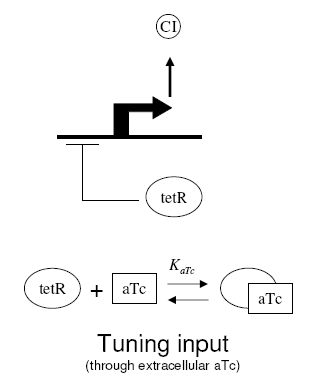Third Meeting, Wednesday, August 9, 2006
From 2006.igem.org
Contents |
Overview
4 basic endpoints: RFP, GFP, LacI and cI. Thus, the thermometer will be divided up into 4 basic modules.
Considerations
- Try to make parts that can be used to build other parts later (ie. Make a part and if test is successful, the part can then be used as is in the next ligation)
- Parallel Processing is KEY. Need to build as many different parts at the same time in order to use our time efficiently. We do not have time to wait and see if one part works before moving onto the next one. On that note, we will probably have to do at least two replicates per part (done by two different people) so that we have at least two cracks at each part
- Once a module is completed, there will first be a simple yes/no test to see if SOME output is produced. If yes, move onto building the second module. While the second module is being constructed, the first module will be more thoroughly tested for linear range, transcription rates, etc.
- All functionality of the parts is in context. One part may work fine in one context but not work in the next
Cell-See-Us Thermometer (2005 Team Design)
Top Level

Basically, LacI is produced, which dimerizes based on temperature: hot --> monomer, cold --> dimer. The dimer then inhibits the production of cI and RFP. cI is a transcription factor that when itself dimerizes, inhibits GFP. So, if cI is inhibited, GFP is produced. Therefore, the thermometer will glow green when cold, red and hot, and some fixed ratio of green:red in between.
Parts Level
Proposed Modules
- I0500 + J06801 + (J04450 – R0010) = I0500 + J06801 + I13507
- I0500 + J06801 + E0240
- Both RFP and GFP will be tested at the same time as the Inverter
- Had to remove the promoter on J04450 and use I0500 instead, but there may be compatibility issues
- Basic test will be to put in Arabinose and measure GFP/RFP, which should be lower than if Arabinose was not present.
- Later on put constant amount of arabinose in and vary the temperature. The fluorescence should vary due to temperature sensitive dimerization
- (I0500 + J06801) + (B0031 + C0056 + B0015) + (I2006 + E0240)
- This is to test the functionality of cI (based on fact that lacI works)
- Parts in brackets will be constructed simultaneously
- If aribinose is present, lacI is produced, some dimerization should inhibit cI and thus result in GFP production
- Again modulate with temperature later on.
- (I0500 + J06801) + (B0031 + C0056 + B0015) + (I2006 + E0240) + J04450
- should theoretically work b/c J04450 was tested in module 1
Further Work/Research
We have at our disposal not only fluorescence analysis but also protein analysis. We need to research if there are simple (and cheap) tests that we can do to detect certain proteins, namely lacI and cI. This will allow us to determine protein production independent of any characteristics in GFP and RFP behaviour.
Control points where we can externally control how much of a certain protein is produced is also very important in allowing us to artificially increase or decrease a signal to make it proportional to another. One such control point has been designed into the circuit through the use of aTc. Once we have a working thermometer we can attempt to verify the model results. After that we can tackle any other control points that may be required.
Finally, on top of everything we have to do, it wouldn’t hurt to keep our minds open to some creative ideas. Ideally, they would be ones that would use some of the parts that we are in the process of testing.


